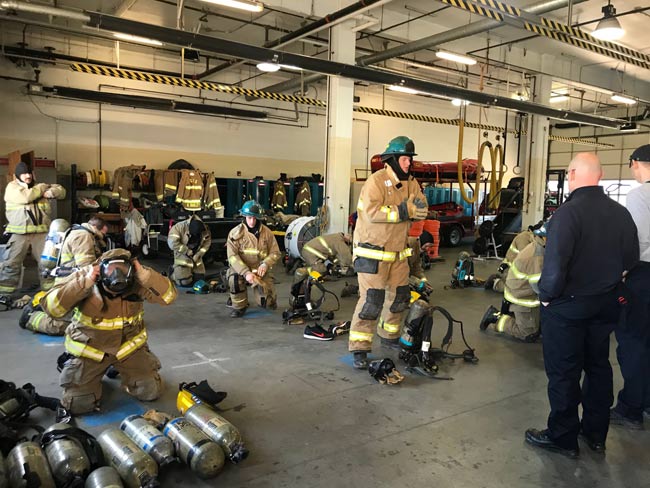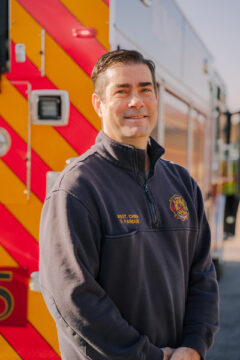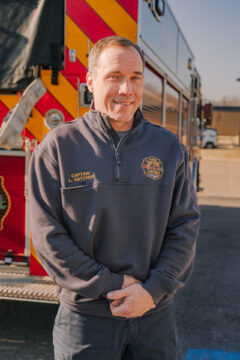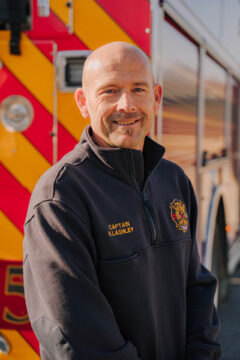Fire / BGFD Fire Academy
The Bowling Green Fire Academy has a long history of preparing and training firefighters. The Academy is 16 weeks and taught by BGFD instructors and the Kentucky Fire Commission. Academy participants do not stay overnight, and will not be away from their families. Recruits attend the local Academy like a 40-hour work week.
Upon graduation from the Academy, firefighters who have not earned their EMT will have a chance to do so.

Overview of Curriculum and Training Areas
- Introduction to the Fire Service and Firefighter Safety – Fire service mission and organization, fire department regulations, policies and procedures, roles and skills of the firefighter, limiting firefighter injuries and fatalities, firefighter safety, health, and wellness, operational safety and scene management.
- Building Construction – Bowling Green is a historic city that is growing. There may be structures in your district that are hundreds of years old and are located next to ones constructed in the past year. Each will conform to a different building code intended to provide a certain level of fire safety and structural stability.
- Fire Dynamics – Fire dynamics describes the meeting point between fire science, materials science, fluid dynamics of gases, and heat transfer.
- Firefighter Personal Protective Equipment – Firefighters work in a wide variety of hazardous environments. To protect your life and health, you must wear the proper safety equipment at all times.
- Ropes and Knots – Ropes and webbing are used to perform many fire service tasks.
- Ground Ladders – Fire service ground ladders are an important part of the equipment that you will use at emergency incidents.
- Forcible Entry – Gaining access into a structure can require firefighters to force locks, doors, windows, or other barriers. The sooner entry can be made, the faster firefighters can control the emergency.
- Structural Search and Rescue – Locating and removing victims requires firefighters to take calculated risks in hazardous situations.
- Tactical Ventilation – Correctly implemented, tactical ventilation helps achieve life safety, incident stabilization, and property conservation.
- Fire Hose – Operations, and Streams – Fire hose is a flexible, portable extension for the water distribution system that carries water from the hydrant or water source to the pumping apparatus. From there, a pump controls the pressure and forwards the water through attack hose lines to the point where it is needed.
- Fire Suppression – Up to this point in your training, you have gained the basic knowledge and skills necessary to control and extinguish fire. Now it is time to learn to apply those skills and knowledge to control fires.
- Overhaul, Property Conservation, and Scene Preservations – After a fire is under control, firefighters still have work at the scene.
- Technical Rescue Support and Vehicle Extrication Operations – Rescues from structure fires are just one type of rescue. Other types, such as confined-space, ropes, trench, swift water, and structural collapse, require specialized training and tools.
- Community Risk Reduction – Community risk reduction is a broad term that incorporates all programs that protect the public using protection, prevention, and education.
- HAZMAT Awareness and Operations – Chemical substances, materials, and products are stored, manufactured, used and transported throughout Bowling Green every day. While these products have necessary beneficial uses, many present considerable risks to the public and to the environment if they are uncontrolled or uncontained. Emergency incidents involving these products may differ from other emergencies in significant ways, and firefighters must be trained to respond safely and effectively.
Meet the Training Division
Assistant Chief Shannon Pardue
Assistant Chief Shannon Pardue joined the BGFD in October of 2003. He has worked as a Firefighter, Fire Engineer, and Fire Captain in the Suppression Division. He also worked as a Captain in the Training Division before taking on the role as Assistant Chief of Training. Chief Pardue oversees the Fire Recruit Training Academy as well as training for the Suppression Division.

Captain Lee Hatcher
Captain Lee Hatcher began his career with the BGFD in 2004. He has been in the Training Division since 2019. He has an Associate degree from Western Kentucky University.

Captain Kevin Lashley
Captain Kevin Lashley began his career with BGFD in October of 2010. He worked as a firefighter for 4 years before testing in 2014 and promoting to the position of Engineer in February of 2015. In 2019 he promoted to the position of Captain/Company Commander. After 21/2 years as a Captain in suppression, Captain Lashley has moved to the Training Division. Captain Lashley takes part in our physical fitness program, EVA, PPE, and is over our Peer Support Program as well as a few others.

